Nearshore software development has become a popular hiring model for startups and businesses looking to optimize their operations and scale efficiently. This model offers several compelling advantages that make it an attractive choice for companies of all sizes. Additionally, nearshore software outsourcing provides specific benefits that enhance development.
Aloa, a software development outsourcing company, has seen these benefits and advantages firsthand. When it comes to nearshore software development, our partner network of over 10,000+ pre-vetted professionals enables us to provide exceptional service tailored to our clients' needs.
Our extensive experience and rigorous vetting process have also given us the knowledge to share our insights on nearshore software development. This blog will explain what it is and how to choose the best nearshore software development company to work with. We'll also outline a few benefits and drawbacks so you can make an informed decision when considering nearshore services for your next project.
Let's get started!
What is Nearshore Software Development?
Nearshore software development is an outsourcing model that involves working with software development companies or teams located in nearby countries, usually within the same or similar timezone. This approach combines the benefits of offshoring with the benefits of geographical proximity.
Companies opt for nearshore development to leverage cost efficiencies, tap into a wider talent pool, and facilitate easier collaboration due to minimal time zone differences. Additionally, businesses that apply a nearshore software development model won't have to vet individual engineers and can instead focus on just vetting the nearshore company.
Adding to its appeal, nearshore development minimizes risks such as cultural fit, language barriers, and time zone differences. Those who apply a nearshore hiring model also find it easier to apply user stories that align with project or business goals.
These provide near-perfect conditions for custom software development projects to prosper, as communication lines between the parent company and the development team significantly become more convenient and manageable.
Nearshore vs Offshore Software Development: Key Differences
Nearshore software development often needs clarification with offshore development. However, these are two distinct types of outsourcing models that startups, companies, and businesses can apply based on their specific needs and priorities.
To simplify the difference between nearshore software outsourcing and offshore outsourcing, let's go through a few concepts that set them apart:
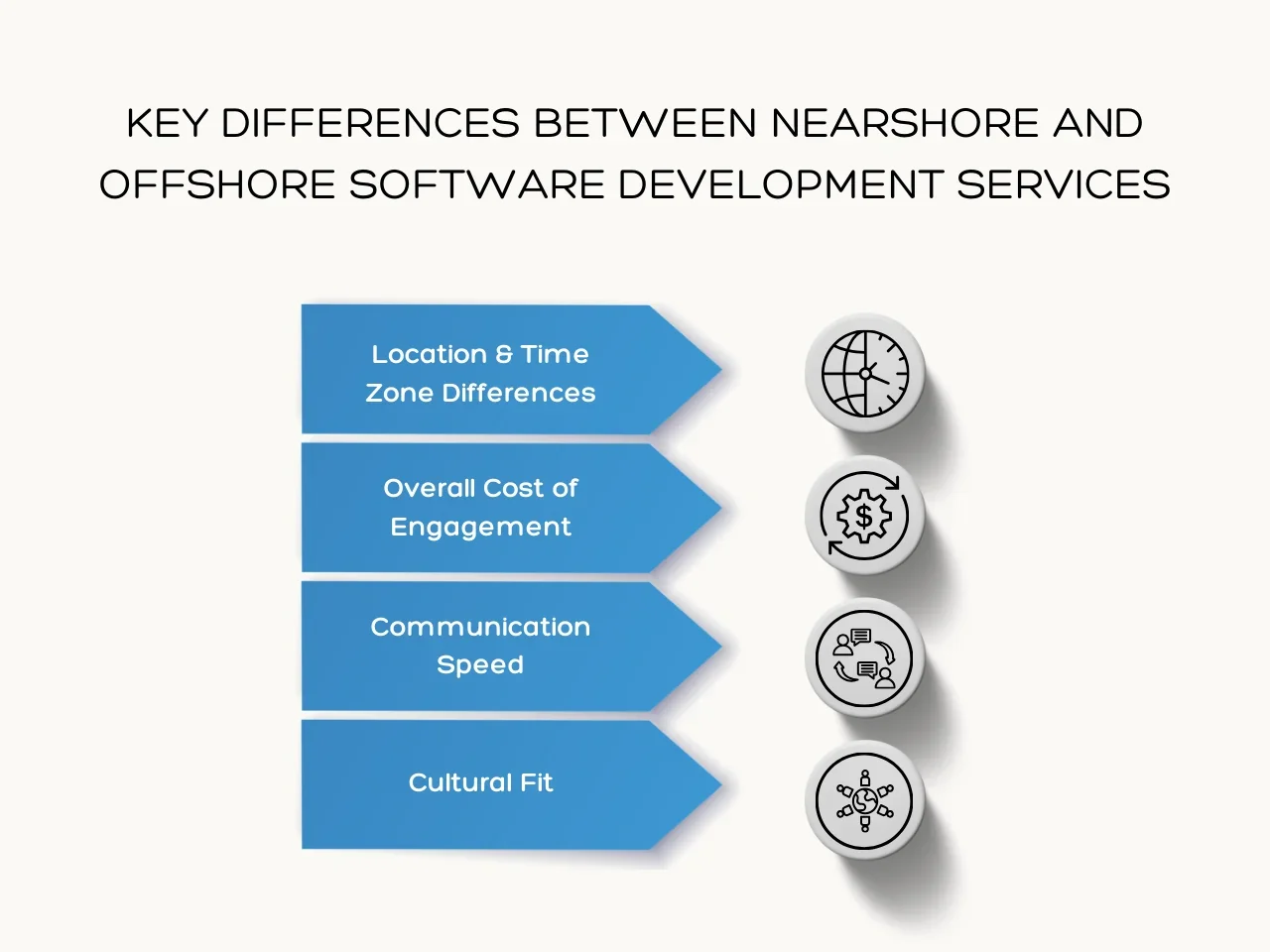
Location & Time Zone Differences
The location is the first significant difference between nearshore software development and offshore outsourcing. Nearshore software development services ensure a client partners with a team or agency within the same geographical region.
For example, a company in the United States would nearshore to developers in Latin America, Mexico, or Canada. Doing so makes it viable for the client company to send someone to coordinate the project or work with a project manager to supervise the development process following a similar time zone.
On the other hand, offshore outsourcing involves a client company working with developers in a different geographical region. For example, a company in the United States would work with developers in Eastern Europe, India, or Asia. The distance covers nearly half the globe, and the time zone difference between the two can be entirely opposite.
In such cases, sending over a coordinator or a project manager is also not feasible due to the long travel time and the vastly different languages and cultures.
Overall Cost of Engagement
Regarding costs, nearshore software development is often the more expensive option because the geographically closer countries are more likely to have similar economic status and cost of living as the client company.
The most significant factor that makes offshoring a cost-effective solution is that the standards of living between two locations vary significantly, allowing offshore companies to charge lower development costs than nearshore and onshore options.
The only similarity between nearshore and offshore outsourcing is that both options still provide a more cost-effective solution than creating an in-house software development team from the ground up. So, when it comes to in-house vs. outsourcing, nearshore and offshore still offer viable options.
Communication Speed
Consistent and effective communication is a vital aspect of software development projects. It serves as the lifeline determining whether you'll have a successful project. With that, communication is the primary consideration that companies take when deciding to outsource their software development.
In the context of nearshore software development services, communication speed is significantly enhanced due to proximity in time zones and cultural understanding and adaptability. Additionally, client companies can expect nearshore partners to have practical tools and technologies similar to their own, such as Zoom, Google Work Space, Slack, etc.
In contrast, offshore development partnerships may pose a risk if the outsourced team you are working with presents challenges due to significant time zone differences, potential language barriers, and differing technological preferences. These can lead to communication delays and integration difficulties.
These differences underscore the importance of selecting a suitable outsourcing model based on communication needs, project complexity, and business objectives.
Cultural Fit
Their cultural fit is another consideration when working with offshore and nearshore software development teams. The cultural difference between a client company and an outsourcing company plays a critical role in whether or not the collaboration will be successful.
A strong cultural fit ensures that both teams share similar values, work ethics, and communication styles, which can significantly enhance cooperation and productivity. Due to geographical proximity, cultural similarities are often more pronounced for nearshore teams, leading to smoother interactions and better alignment with the client company's business practices.
In some cases, offshore teams may face greater challenges due to more significant cultural differences. These differences can impact communication, decision-making processes, and overall team dynamics.
Misunderstandings and misalignments may occur more frequently, potentially leading to delays and inefficiencies. To mitigate these challenges, companies should invest in cultural training and establish clear communication protocols when establishing a remote work culture.
How to Choose the Best Nearshore Software Development Company to Work With
Having outlined the considerations of nearshore software development, the next step is to understand how to choose the best company to work with.
Here are some critical steps to guide your decision-making process:

Step 1: Define Project or Business Goals and Objectives
The first step in choosing the right nearshore software development company to work with is defining project or business goals and objectives. Nearshore developers come with various skills and backgrounds today, so knowing your specific goals is essential for finding the best match. Start by outlining the following:
- Project Scope: Clearly define the overall scope of your project by outlining its primary purpose, the main deliverables, and expected outcomes.
- Desired Functionalities: Specify the essential functions and features required. It's best to include the must-have features rather than the nice-to-have. You can also specify the technology and tools needed to implement such functions.
- Timeline of Expectations: Establish a realistic timeline for the project by detailing when it will start and when it should be completed. Including the deadlines for key milestones also ensures your project stays on track.
- Budget Constraints: Include a breakdown of your maximum spending and whether you are willing to invest more or less.
- Scalability: Consider the features you will require to accommodate growth and expansion, such as increases in user demand or better quality.
- Tech Requirements: Outline specific technical requirements, such as what programming languages, frameworks, and platforms your application will need.
Clearly stating these points right away ensures that you effectively communicate your requirements to potential nearshore software development service partners and that they align their services with your strategic objectives.
Step 2: Outline Required Skills and Expertise
Once you know your project or business goals in working with nearshore developer professionals, you'll clearly understand the skills and expertise needed. To get started, consider the technical and soft skills your ideal candidate should possess to keep things running smoothly during project implementation.
Here are the technical skills to consider when working with nearshore developer teams or companies:
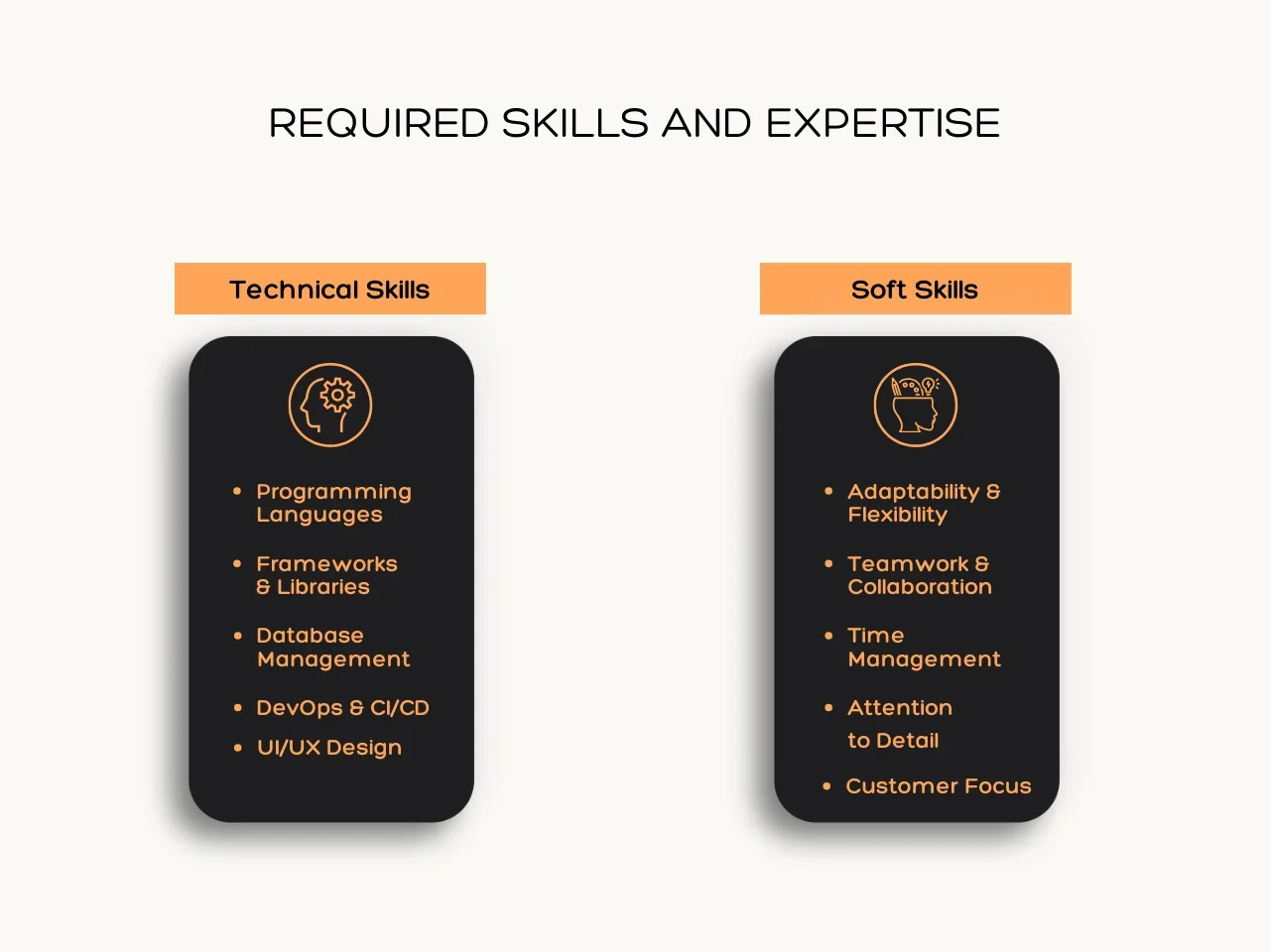
- Programming Languages: Look for nearshore teams with expertise in commonly used programming languages. This ensures they can apply the right language to your application or software.
- Frameworks and Libraries: Expertise in several frameworks enables your nearshore developers to speed up development and ensure high-quality outcomes significantly.
- Database Management: Evaluate the team's experience with database management systems. Proficiency in both relational and non-relational databases is crucial for managing data effectively.
- DevOps and CI/CD: Look for expertise in DevOps practices and continuous integration/continuous deployment (CI/CD) tools. These skills are important for automating and streamlining the development pipeline.
- UI/UX Design: A good understanding of user interface (UI) and user experience (UX) design is crucial for creating intuitive and engaging applications.
Here are the soft skills to look for when vetting nearshore software development services:
- Adaptability and Flexibility: Teams that can adapt to changing requirements while remaining flexible ensure your project succeeds.
- Teamwork and Collaboration: Nearshore developers who show cooperation and support among team members can contribute to a positive team dynamic.
- Time Management: Developers who prioritize tasks, manage their workload effectively, and deliver on time are valuable assets.
- Attention to Detail: Precision and accuracy are critical in software development, and strong attention to detail reduces the risk of errors and leads to high-quality results.
- Customer Focus: A strong customer focus ensures the development team prioritizes the client's needs and delivers solutions that meet or exceed expectations.
Paying attention to these skills while searching for a nearshore partner specializing in software development services like web development, mobile app development, or custom software development can give you a better chance of finding the right talent.
Step 3: Explore Nearshore Development Company Options
After listing the technical and soft skills you'll require from your nearshore software development services, it's time to start compiling a list of options. Nearshore software development companies vary in their services and often specialize in linking client companies with specific regions.
Based on your geographical location, it's essential to consider where a nearshore software development company sources its professionals. Aside from that, considering the following aspects ensures you work with the best team: company reputation, service offerings, client, portfolio, and communication practices.
Step 4: Assess and Vet Shortlisted Options
Having a list of potential companies to work with streamlines your ability to shortlist the most well-suited options into a shortlist. Your shortlisted options should include companies that directly fit your project scope and align with your needs as a business, whether in the short term or long term.
As you shortlist your options, here are the aspects that will aid you in narrowing down the best fit nearshore companies:
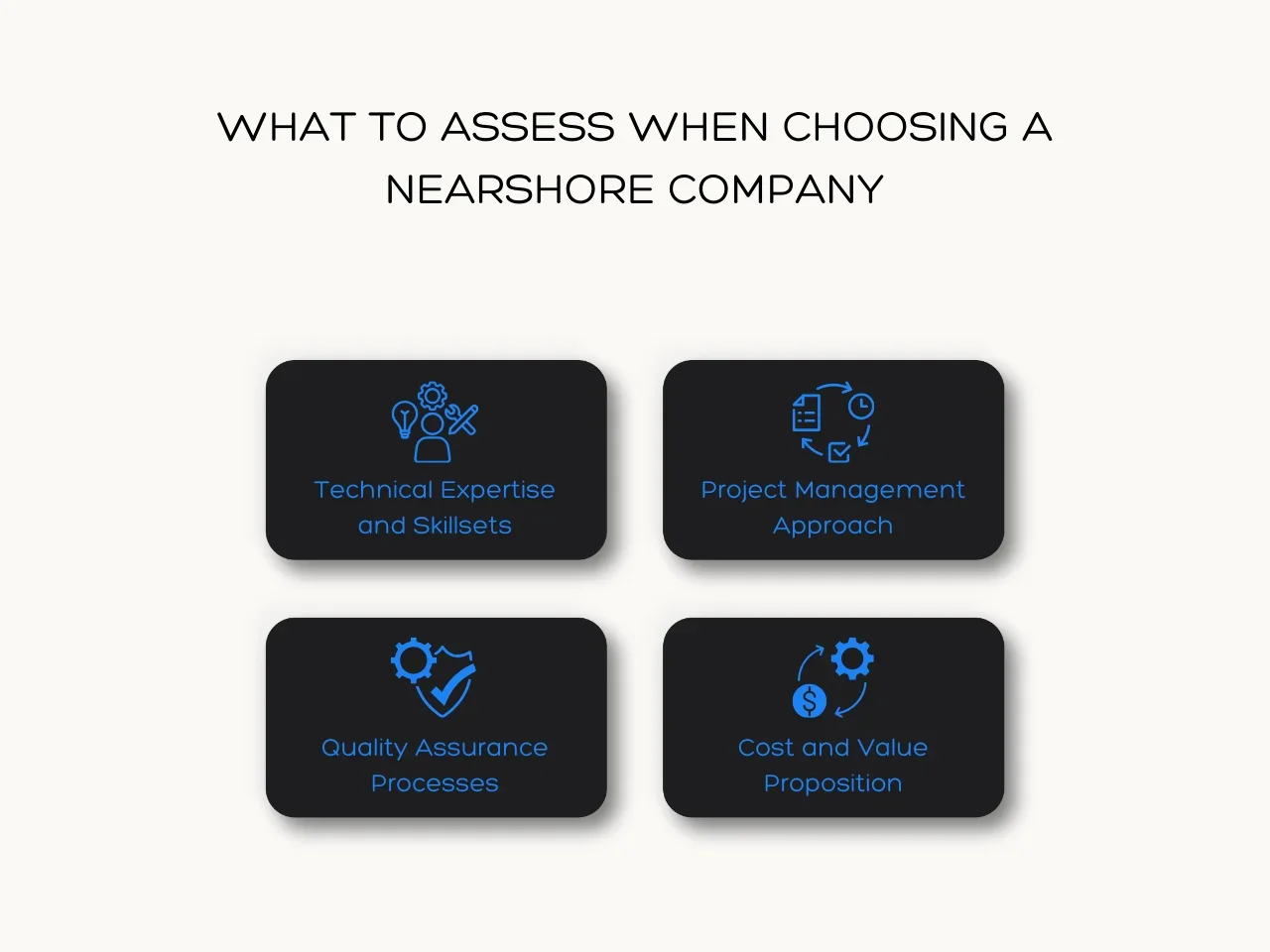
- Technical Expertise and Skillsets: Ensure the company you work with fronts developers have the skills and expertise required for your project. Take the time to review their experience relevant to your needs.
- Project Management Approach: Look into the company's understanding of project management methodologies, whether they follow Agile, Scrum, or another approach.
- Quality Assurance Processes: Investigate the company's quality assurance processes. Strong QA practices ensure the final product is free of defects and meets your quality standards.
- Cost and Value Proposition: Compare your shortlisted options' cost structures and value propositions. Ensure transparency in pricing and evaluate the overall value they offer in terms of quality, expertise, and service.
Step 5: Finalize Partnership and Begin Onboarding Processes
The best way to finalize which company to work with is to schedule discovery and consultation calls with shortlisted options. These calls allow you to delve deeper into each company's capabilities, communication practices, and overall fit for your project. Clearly articulate your project goals, scope, and expectations during these discussions to ensure alignment.
After selecting the best fit, formalize the partnership through a detailed contract outlining project deliverables, timelines, milestones, and payment terms. This contract should also cover confidentiality agreements, intellectual property rights, and other legal considerations pertinent to the partnership.
With the partnership finalized, initiate the onboarding process. This involves setting up communication channels, integrating project management tools, and conducting kickoff meetings to align teams. By thoroughly preparing and establishing a clear framework for collaboration, you can set the foundation for a successful nearshore software development partnership.
Benefits and Drawbacks of Nearshore Software Development
Understanding whether nearshore software development services are right for your business or project needs means taking a closer look at their benefits and drawbacks. Weighing these considerations against your business's ultimate goal ensures you choose the right team, model, and professionals to work with.
Let's go through the core benefits and drawbacks to keep in mind when choosing nearshore development services:
Benefits of Choosing Nearshore Software Development Services
Nearshore software development proves to bring with it unique advantages that onshoring and offshoring can not replicate:
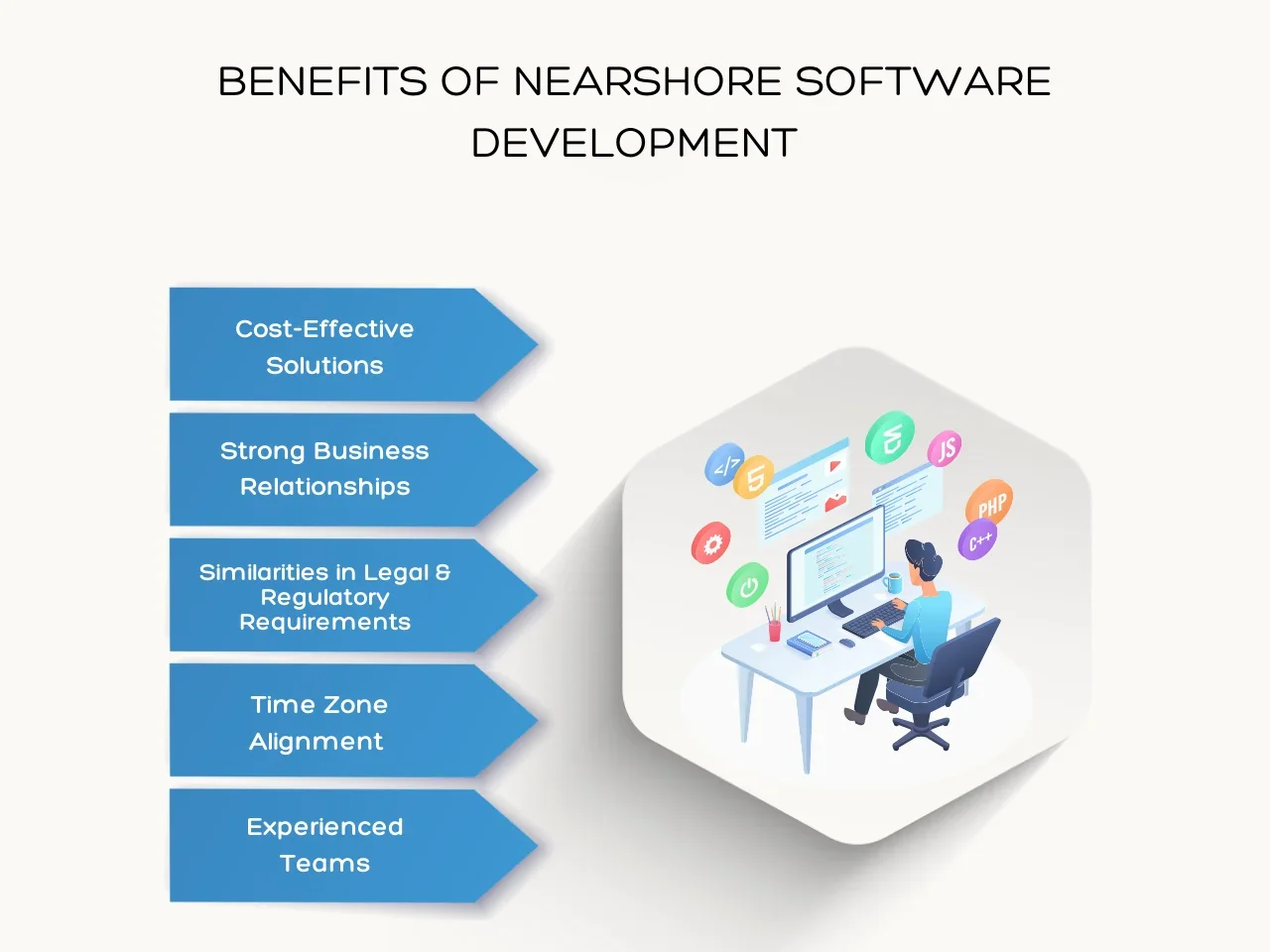
Cost-Effective Solutions
Hiring a team of skilled nearshore developers can be expensive, especially if you build your team from the ground up. In such cases, onshoring is the most costly choice since it requires you to spend the most time and effort in finding, interviewing, and hiring employees. These processes can be incredibly taxing when you factor in payroll and human resource overhead costs.
Offshoring is the cheapest way to build your developer team. Still, it is also the riskiest if you do not enforce strict processes and procedures, such as Aloa's infrastructure, to manage time zone differences, cultural disparities, and potential communication barriers. Nearshoring strikes a balance, offering substantial cost savings without the extreme risks associated with offshoring. It offers lower-cost solutions with effective results.
To put things into perspective, the average hiring rate for software developers in Eastern Europe (Ukraine, Poland, Hungary, Romania) is $37. In contrast, in Western Europe (Germany, France, Italy, United Kingdom), software developers range around $66.
Based on this information, a Western European company nearshoring to Eastern Europe saves almost half the cost compared to onshoring or hiring their teams. The price is even lower for Latin America, Asia Pacific, and Africa. However, when hiring from these locations, keep in mind the potential risks, including language and cultural differences and ease of doing business.
Strong Business Relationships
Strong business relationships are an essential aspect of outsourcing. This is because you rely on your team to ensure things get done on time based on the rates you've agreed upon. Relationship building makes things run smoothly during implementation, so having a healthy work environment with all involved works towards that goal.
Nearshoring perfectly fits in the middle of the outsourcing options as it offers the chance for both parties to learn more about each other's unique identities while simultaneously providing enough common ground for them to be comfortable with each other's cultural backgrounds.
Additionally, language barriers are easier to manage with nearshore activities since the likelihood of closer regions sharing a similar language or being familiar with both languages is already a plus for communication and relationship building.
Similarities in Legal and Regulatory Requirements
Another benefit of nearshoring is the similarities in legal and regulatory requirements, which are particularly important for software product development.
Data protection and privacy are critical areas of concern for governing bodies in the digital world. With many countries having their own privacy and data protection laws, managing all the bureaucracy can be challenging.
Geopolitical issues, such as the US-China Trade War, recent escalations in the Russo-Ukrainian War, or even a civil conflict, such as the Myanmar military coup, can also pose a severe risk to offshore outsourcing setups.
Nearshoring can minimize the risk of these issues. European countries inside the European Union have a much easier time dealing with all the legal issues involved, especially when it comes to legal and regulatory issues.
Nearshoring also benefits from the ease of monitoring stability in a region that is close and familiar to the company's host geographical area.
Time Zone Alignment
As mentioned earlier, time zone alignment is one of the best advantages of nearshore software development. When outsourcing to a nearshore team, your team can expect a much faster response time to messages as work hours align.
One of the most problematic aspects of remote working and offshore outsourcing is coordinating asynchronously, but working with a nearshore team means you can communicate in real time.
Experienced Teams
Lastly, nearshore setups benefit tremendously from experienced teams and employees. As the distance isn't too far and the economic statuses between regions shouldn't be drastically different, this provides a reassuring fact that the quality and experience of the talent that businesses hire is guaranteed to a certain level.
This is because "experienced" can be defined differently in other areas of the globe. The standards of an experienced software developer in India or China can be different from those in Europe or the Americas.
This is simply because these unique regions have their own expertise, specializations, language nuances, or systems of education that are often different from other areas in the world. Nearshoring and onshoring don't have this much of an issue, as the close geographical proximity between the two parties provides an idea of what these standards ought to be.
Drawbacks of Nearshore Software Development Services
Nearshore software development is all good, but is it the perfect solution when outsourcing? Not always. Let's take a look at some drawbacks that businesses have to face when it comes to deciding on choosing nearshoring as their go-to setup:
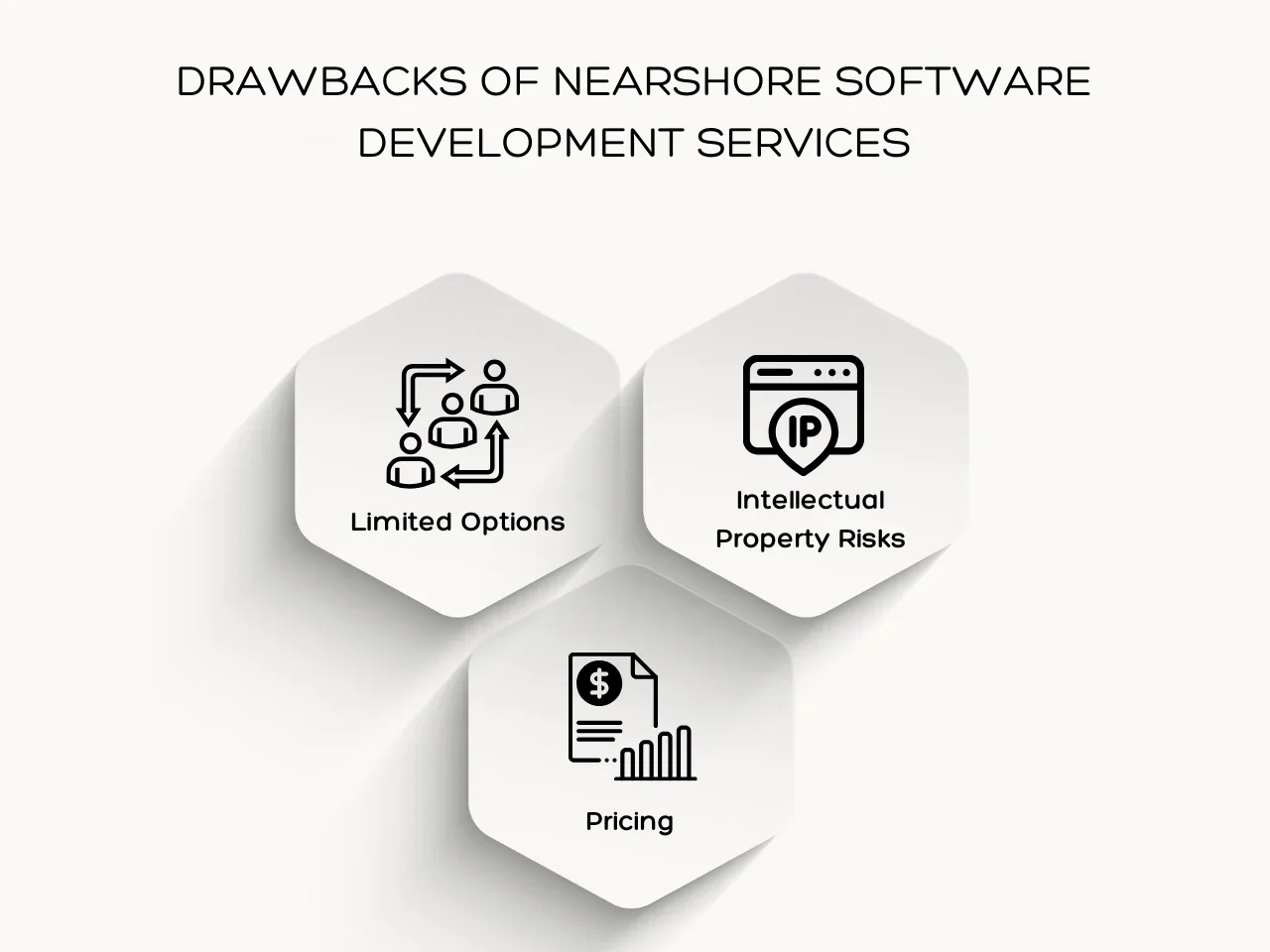
Limited Options
There aren't as many nearshoring companies as offshoring ones. You might have limited options if you plan to go for a nearshore software development partner.
Looking at other nearby regions could also help. However, it still isn't convenient to hop around different countries and their unique circumstances to extend your list of nearshoring companies to choose from.
Intellectual Property Risks
IP theft is a risk that is still present whenever working in any outsourcing setup. It is simply an inherent risk when working with a third-party contractor. Many US companies prefer to outsource to Mexico as it operates under the same Intellectual Property guidance and regulations used in the United States. However, It doesn't mean the risk doesn't exist, and it should still be a consideration when choosing your outsourcing partner.
Pricing
Nearshoring pricing is unlikely to compete with offshoring prices. If you plan to invest in a nearshoring setup, expect to spend more cash than you would if you hired an offshoring service provider. However, both are more cost-effective than hiring an onshore team.
Key Takeaway
Working with a nearshore software development company has its strategic advantages. It offers a sweet spot between onshoring and offshoring, providing the benefits of geographical proximity, such as similar time zones and cultural alignment, which enhance communication and collaboration.
Startups and businesses that apply a nearshore model reduce the overhead costs of hiring and maintaining an in-house team and mitigate the risks commonly linked with offshore outsourcing. Furthermore, nearshore companies bring a wealth of talent and expertise, often at a fraction of the cost of local hiring, enabling you to access top-tier professionals and cutting-edge technologies without breaking the bank.
Leverage the benefits of working with a nearshore software development team by contacting our team at [email protected], our Account Executives can walk you through building your team and starting your project!

